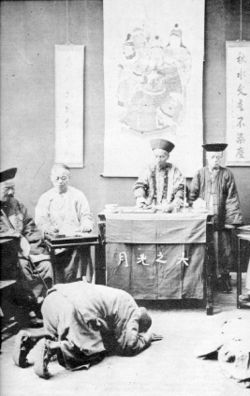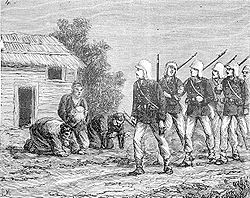- Kowtow
-
Kowtow 
Kowtowing in a court Chinese name Traditional Chinese 叩頭 or 磕頭 Simplified Chinese 叩头 or 磕头 Hanyu Pinyin kòutóu or kētóu Literal meaning kowtow ("knock head") Transcriptions Hakka - Romanization [kieu˥ teu˩] Mandarin - Hanyu Pinyin kòutóu or kētóu Min - Hokkien POJ khàu-thâu (叩頭)
kha̍p-thâu (磕頭)Wu - Romanization [kʰəʔdɤɯ] (磕頭 only) Cantonese (Yue) - Jyutping kau tàuh (叩头 only) Japanese name Kanji 叩頭 (noun); 叩頭く (verb) Hiragana こうとう (noun); ぬかずく or ぬかつく (verb) Transcriptions - Romaji kōtō (noun); nukazuku or nukatsuku (verb) Korean name Hangul 고두 Hanja 叩頭 Transcriptions - Revised
Romanizationgodu Vietnamese name Quốc ngữ khấu đầu Hán tự 叩頭 Kowtow is the act of deep respect shown by kneeling and bowing so low as to have one's head touching the ground. An alternative Chinese term is ketou, however the meaning is somewhat altered: kòu originally meant "knock with reverence", whereas kē has the general meaning of "touch upon (a surface)".
In Han Chinese culture, the kowtow is the highest sign of reverence. It was widely used to show reverence for one's elders, superiors, and especially the Emperor, as well as for religious and cultural objects of worship. In modern times, usage of the kowtow has become much reduced.
Contents
Traditional usage
In Imperial Chinese protocol, the kowtow was performed before the Emperor of China. Depending on the solemnity of the situation different grades of kowtow would be used. In the most solemn of ceremonies, for example at the coronation of a new Emperor, the Emperor's subjects would undertake the ceremony of the "three kneelings and nine kowtows", which involves kneeling from a standing position three times, and each time, performing the kowtow three times while kneeling. Immanuel Shu describes the "full kowtow" as "three kneelings and nine knockings of the head on the ground."[1]
As government officials represented the majesty of the Emperor while carrying out their duties, commoners were also required to kowtow to them in formal situations. For example, a commoner brought before a local magistrate would be required to kneel and kowtow. A commoner is then required to remain kneeling, whereas a person who has earned a degree in the Imperial examinations is permitted a seat.
Since one is required by Confucian philosophy to show great reverence to one's parents and grandparents, children may also be required to kowtow to their elderly ancestors, particularly on special occasions. For example, at a wedding, the marrying couple was traditionally required to kowtow to both sets of parents, as acknowledgement of the debt owed for their nurturing.
Confucius believed there was a natural harmony between the body and mind and therefore, whatever actions were expressed through the body would be transferred over to the mind.[citation needed] Because the body is placed in a low position in the kowtow, the idea is that one will naturally convert to his or her mind a feeling of respect. What one does to oneself has an impact on the mind. Confucian philosophy held that respect was important for a society, making bowing an important ritual.
Modern usage
The kowtow, and other traditional forms of reverence, were much maligned after the May Fourth Movement. Today, only vestiges of the traditional usage of the kowtow remain. In many situations, the standing bow has replaced the kowtow. For example, some, but not all, people would choose to kowtow before the grave of an ancestor, or while making traditional offerings to an ancestor. Direct descendants may also kowtow at the funeral of an ancestor, while others would simply bow. During a wedding, some couples may kowtow to their respective parents, though the standing bow is today more common. In extreme cases, the kowtow can be used to express profound gratitude, apology, or to beg for forgiveness.
The kowtow remains alive as part of a formal induction ceremony in certain traditional trades that involve apprenticeship or discipleship. For example, Chinese martial arts schools often require a student to kowtow to a master. Likewise, traditional performing arts often also require the kowtow.
Religion
The kowtow is often performed in groups of three before Buddhist statues and images or tombs of the dead. In Buddhism it is more commonly termed either "worship with the crown (of the head)" (頂禮 ding li) or "casting the five limbs to the earth" (五體投地 wuti tou di) - referring to the two arms, two legs and forehead. For example, in certain ceremonies, a person would perform a sequence of three sets of three kowtows - stand up and kneel down again between each set - as an extreme gesture of respect; hence the term three kneelings and nine head knockings (三跪九叩). Also, some Buddhist pilgrims would kowtow once for every three steps made during their long journeys. Often the number three referring to the Triple Gem of Buddhism, the Buddha, Dharma, and Sangha.
Diplomacy and the West
Kowtow came into English in the early 19th century to describe the bow itself, but its meaning soon shifted to describe any abject submission or grovelling. Many Westerners who first encountered the practice believed it was a sign of worship, but kowtowing does not necessarily have religious overtones in traditional Chinese culture.
The kowtow was a significant issue for diplomats, since it was required to come into the presence of the Emperor of China, but it meant submission before him. The British embassies of George Macartney, 1st Earl Macartney (1793) and William Pitt Amherst, 1st Earl Amherst (1816) were foiled, since kowtowing would mean acknowledging their King as a subject of the Emperor.
Dutch ambassador Isaac Titsingh did not refuse to kowtow during the course of his 1794-1795 mission to the Imperial Court of Emperor Qianlong.[2] The members of the Titsingh mission, including Andreas Everardus van Braam Houckgeest and Chrétien-Louis-Joseph de Guignes, made every effort to conform with the demands of the complex Imperial court etiquette. Neither the Chinese nor these Europeans could have known that this would be the last appearance by any Western ambassador at the Imperial court until after the Opium Wars of the next century.
The kowtow was often performed in intra-Asian diplomatic relations as well. In 1636, Injo who was king of the Korean Joseon Dynasty had to kneel three times on the ground and touch his head three times on the ground (三拜三叩頭禮), to show his allegiance to Huang Taiji who was the first Emperor of the Qing Dynasty.[3] The King of the Ryukyu Kingdom also had to kneel three times on the ground and touch his head nine times to the ground (三拜九叩頭禮), to show his vassal status to the Chinese Dynasty.[4]
See also
- Chinese social relations
- Culture of China
- Finger kowtow:
- Posture emoticons
- Foot washing, another act of extreme humility
- Gadaw, a Burmese form of obeisance akin to kowtow
- John Moyse
- Salute
- Sifu
- Sujud
- Orz
- Dogeza
- Proskynesis
Notes
- ^ Hsu, Immanuel (1970). The Rise of Modern China. New York: Oxford University Press. p. 152. ISBN 7883022.
- ^ van Braam Houckgeest, Andreas Everardus. (1798). An authentic account of the embassy of the Dutch East-India company, to the court of the emperor of China, in the years 1794 and 1795, Vol. I (English edition). pp. 285 in original (p. 335 of pp. 339 in digitized format).
- ^ (in Chinese character) 仁祖 34卷, 15年 (1636) 正月30日. Annals of Joseon Dynasty. "龍胡入報, 出傳汗言曰: “前日之事, 欲言則長矣。 今能勇決而來, 深用喜幸。” 上答曰: “天恩罔極。” 龍胡等引入, 設席於壇下北面, 請上就席, 使淸人臚唱。 上行三拜九叩頭禮。"
- ^ 重点領域研究「沖縄の歴史情報研究 (History Study of Okinawa). http://www.hi.u-tokyo.ac.jp/personal/tsuruta/sei0005.htm. "– 「通航一覧・琉球国部 正編 巻之二十三 琉球国部二十三、唐国往来」""(Japanese)
References
- Rockhill, William Woodville. "Diplomatic Missions to the Court of China: The Kotow Question I," The American Historical Review, Vol. 2, No. 3 (Apr., 1897), pp. 427–442.
- Rockhill, William Woodville. "Diplomatic Missions to the Court of China: The Kotow Question II," The American Historical Review, Vol. 2, No. 4 (Jul., 1897), pp. 627–643.
Gestures Friendly gestures Air kiss · A-ok · Cheek kissing · Dap greeting · Elbow bump · Eskimo kissing · Fist bump · Hat tip · High five · Hongi · ILY sign · Namaste · Sign of the horns · Shaka · Thumbs signal · WaiFormal gestures Salutes Bellamy salute · Nazi salute · Raised fist · Roman salute · Scout sign and salute · Three-finger salute · Two-finger salute · Vulcan salute · Zogist saluteCelebratory gestures Finger counting Obscene gestures Head motions Other gestures Air quotes · Anasyrma · Crossed fingers · Facepalm · Finger gun · Gang signal · Hand-rubbing · Jazz hands · Kuji-in · Laban sign · Loser · Mudra · Pollice verso · Puppy face · Shrug · Sign of the Cross · Varadamudra · V signRelated Categories:- Chinese culture
- Etiquette
- Human body positions
- Chinese words and phrases
Wikimedia Foundation. 2010.

